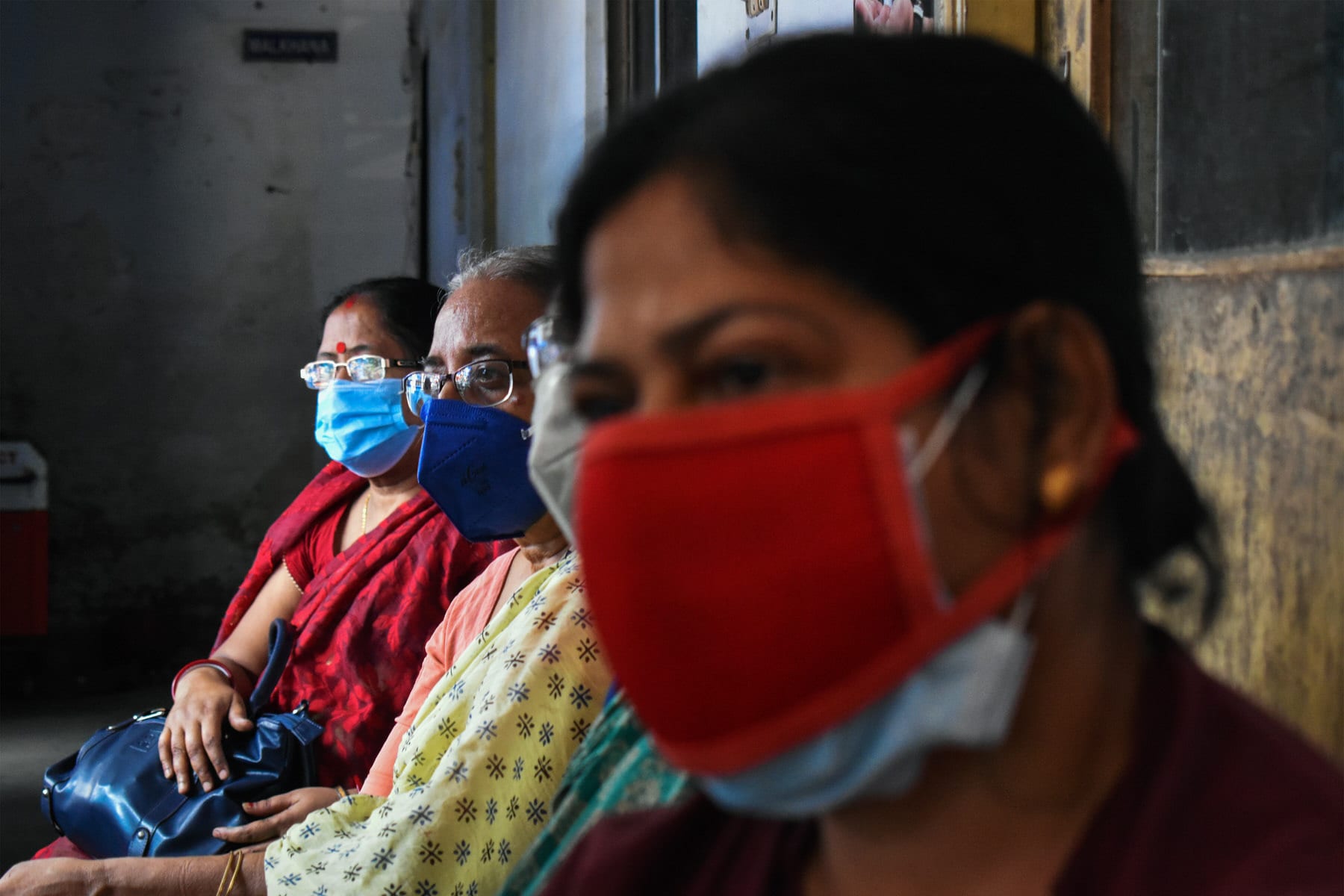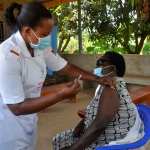For over a year, the global health community has been sounding the alarm about what the coronavirus crisis could mean for gender equity efforts worldwide. Early research paints a grim picture: increases in unintended pregnancies, higher rates of gender-based violence, more young girls dropping out of school and getting married. But it will take years for the full effects to become clear.
The health crisis appears on the wane in the United States, but worldwide, vaccine access is limited and COVID-19 is surging. Cases in India are so high that hospitals are running out of beds and oxygen, and experts say the surge will spread to other countries.
That’s troubling, says Dr. Natalia Kanem, who heads the United Nations Population Fund (UNFPA). Kanem, a medical doctor and epidemiologist by training, focuses on global reproductive health and gender equity. Already, she is worried about how the pandemic has affected women and girls across the globe. Without support from nations like the United States — which already has purchased more than enough vaccines to immunize the entire country — the consequences could be severe.
Kanem spoke with The 19th about how the pandemic has affected reproductive health access and the broader implications if the coronavirus surge is not reversed.
This conversation has been edited for length and clarity.
Shefali Luthra: When all this began, what kind of impact did you expect? And at what point did you start to worry about the reproductive health ramifications?
Dr. Natalia Kanem: Our whole team looked around and understood that movement restriction seemed to be a first order of response. This can also have a devastating impact on people who are vulnerable, whether it is because a woman is in a remote location, or a girl is not going to school, she is now vulnerable to issues like child marriage and female genital mutilation.
Our real fear was gender-based violence skyrocketing. We also worried about lack of access to contraception, because women might be behind blockades or just be scared to go to their regular clinic.
What has the pandemic meant for access to contraception? And how did it exacerbate some of the barriers that already existed?
UNFPA has been on the ground throughout the pandemic trying to ensure that sexual and reproductive health was classified as essential, which has not been true in every case.
With contraception, it wasn’t as bad as we thought it was going to be. Initially, we thought that with 12 million women losing access to contraception, that we might have as many as 2 million or so unintended pregnancies. We did better.
But then you did the comparison for developing countries versus the rich countries. There was no baby boom in the rich countries because women had access to contraception. In times of uncertainty, people typically will not want to start families. But in the developing world, the access was not there.
It wasn’t a huge baby boom, but the rate of teen pregnancy has gone up. Kenya has documented this, and others, subsequently. It’s not going to be as bad as we thought originally, but the rate of unintended pregnancy also went up.
Things like economic shutdowns and school closures — what role did those play in women’s unemployment, and bigger picture, in affecting gender-based health inequities?
Typically, in other crises, girls who drop out of school don’t go back. Some of the boys do, usually the girls don’t. And that has a devastating effect on the future for the economic power of a girl.
The logistics were compounded by — how can I put this delicately — in the diplomatic sphere, women’s issues were not prioritized. So personal protective equipment for the female workforce was a huge hurdle. Up to today, we have a nurse, we have a cleaner — of course, men as well as women, but the health workforce we estimate is 70 percent female. They’re scared to bring COVID home.
And there is the pervasive nature, even when there is no crisis, of women’s bodily autonomy not being respected. If the girl is home from school, that sets up a whole new dynamic where she’s not reporting to other adults besides those that surround her in the neighborhoods. She is vulnerable by being available. And the pressures on the household have meant that some people are turning to early marriage as a “solution.” Violence all the way up to femicide has increased.
Our prediction sadly did come true. For contraception, people rallied. On this other sphere, it’s really been a disaster.
Independently of early marriage and female genital mutilation, we estimate violence within the home rose by 20 percent during lockdowns. One in three is the estimate over the lifetime of a woman of being victimized by gender-based violence. But now what we see is that during the lockdowns, violence increased by 20 percent, leading to over 1 million additional cases of domestic violence every single week of this pandemic. When you multiply those weeks to make it a year, and now we’re in the second year, it is horrendous.
“…during the lockdowns, violence increased by 20 percent, leading to over 1 million additional cases of domestic violence every single week of this pandemic.”
We projected [gender equity] program disruptions. We would have an additional, beyond the baseline, 2 million cases of female genital mutilation and 13 million cases of child marriage over the next decade to be blamed squarely on the health system breakdown, program disruption, school closure. We just did a survey in a refugee camp in Kenya called Dadaab. Dadaab has already documented an increase of 20 percent in female genital mutilation since March last year.
Longer term, what are these effects and trends going to mean, and how long is it going to take for us to fully understand the impact of what this has meant for women and girls?
Pregnancies don’t stop for pandemics. Access to life-saving contraception and reproductive care is a basic right. And sexual and reproductive health is essential health care everywhere, all the time. So the pandemic is kind of being layered onto a situation where the essential needs of women were already not being respected.
If anything, it shows us that the type of inequality that we have in this world is absolutely not sustainable. We really have to uphold the rights of women to determine what happens to their body.
Looking at the longer-term picture, we are scrambling to get data that is disaggregated appropriately. The top-level story doesn’t tell us the details of what happened to the rural girl age 12 to 15, who was either in school or out. When we look at the planning that it’s going to take to ensure that boys and girls have the right kind of information, to engage in healthy, safe behavior — this was already on the agenda. But now to me it shows us the urgency.
Another point was, as we’re talking about the new workplace, this is more evidence of why we need to support paternity and parental leave policies so that men, too, can participate in caregiving. It’s been a real eye-opener that many men stepped up. Perhaps not enough, but many men. This old mythology that “oh, no, you know, the woman must do it all” — it’s been blown apart.
It seems clear other countries will be in a state of health emergency for much longer than the United States. What are the implications for reproductive autonomy and for gender equity? Are there some countries where things might get worse, and others where it gets better?
It’s been painful to see the scramble for equitable vaccine access.
Inequalities can no longer be justified. We are really pleading with the world that has vaccines — and some in excess — to join this effort to, in a methodical way, get life-saving vaccines to countries who otherwise will be at the bottom of the barrel.
One other quick thing: We’ve been following the advice for pregnant women. And big studies reported just last week assured us that it is better and protective for pregnant women to be vaccinated. So that’s something that I’m glad there’s data now to buttress the recommendations.
Thinking about what we’re seeing in India — are you worried about what the coming months or even years could look like not just in South Asia, but worldwide? And what should countries like the United States be doing?
It is lamentable, what we’re seeing in places like India, Brazil, the USA, parts of Europe. Certainly I think there are many under-the-radar, burgeoning pandemics all over the world.
We succeed when we work in solidarity. There is no way that one can isolate one’s country from a pandemic, which is fast-moving, and also developing variants. This fight against COVID is not bound by geography or privilege. A virus anywhere is a virus everywhere.
“We would have an additional, beyond the baseline, 2 million cases of female genital mutilation and 13 million cases of child marriage over the next decade to be blamed squarely on the health system breakdown, program disruption, school closure.”
Leaving behind certain parts of the world is not going to work. And what I’ve also been at pains to say is that, no matter what the tragedy may be, women and girls bear the brunt. They’re the last to be fed, and they’re fed the least. They’re the first to sacrifice their health care so that everybody else can be taken care of.
Apart from urging the international community to play their part in ensuring that the vaccines are distributed equitably, we also need to look at the fundamental weaknesses of power imbalance. Equal rights may exist on paper, but they’re not translated into reality.
What have I not asked you that you think I should?
What we’ve been talking about is not revolutionary. I mean, we’ve been talking about the bare minimum.
We don’t have to wait 3,000 years for people to stop beating their wives. It should stop now. The same with crimes like sexual assault. People should be identified and perpetrators should be punished. It’s not a victim-blaming exercise anymore. I believe that women themselves have taken the mantle and said, “We refuse to be disempowered. It’s actually not about empowerment, we want some real power. And not only in the home, but in every stratum of society.”
I think this is a tipping point where we can get serious about some of these issues of real equality for women and girls.






